
By Karen Rubin, Travel Features Syndicate, goingplacesfarandnear.com
When I signed on to Royal Expeditions’ new “Jungle Book Wildlife Safari & Cycling Adventure” in India, I couldn’t believe or even visualize the concept of cycling through a wildlife sanctuary populated with tigers, leopards, sloth bears, wild dogs, langur monkeys and jackals. And Royal Expeditions which devised this innovative, out-of-the-box trip, set in the same region as Rudyard Kipling’s beloved 1895 story, didn’t ask how fast I could ride (or, for that matter, whether I had any experience in single-track off-road biking). But here I am, on a rough cut, overgrown, rolling trail that serves as a forest corridor between the two national parks known for tigers – Pench and Kanha – where animals, including tigers, roam freely. This is confirmed when a naturalist who rides along with us points out tiger pugmarks (paw prints) in a sandy section of the trail we are riding.
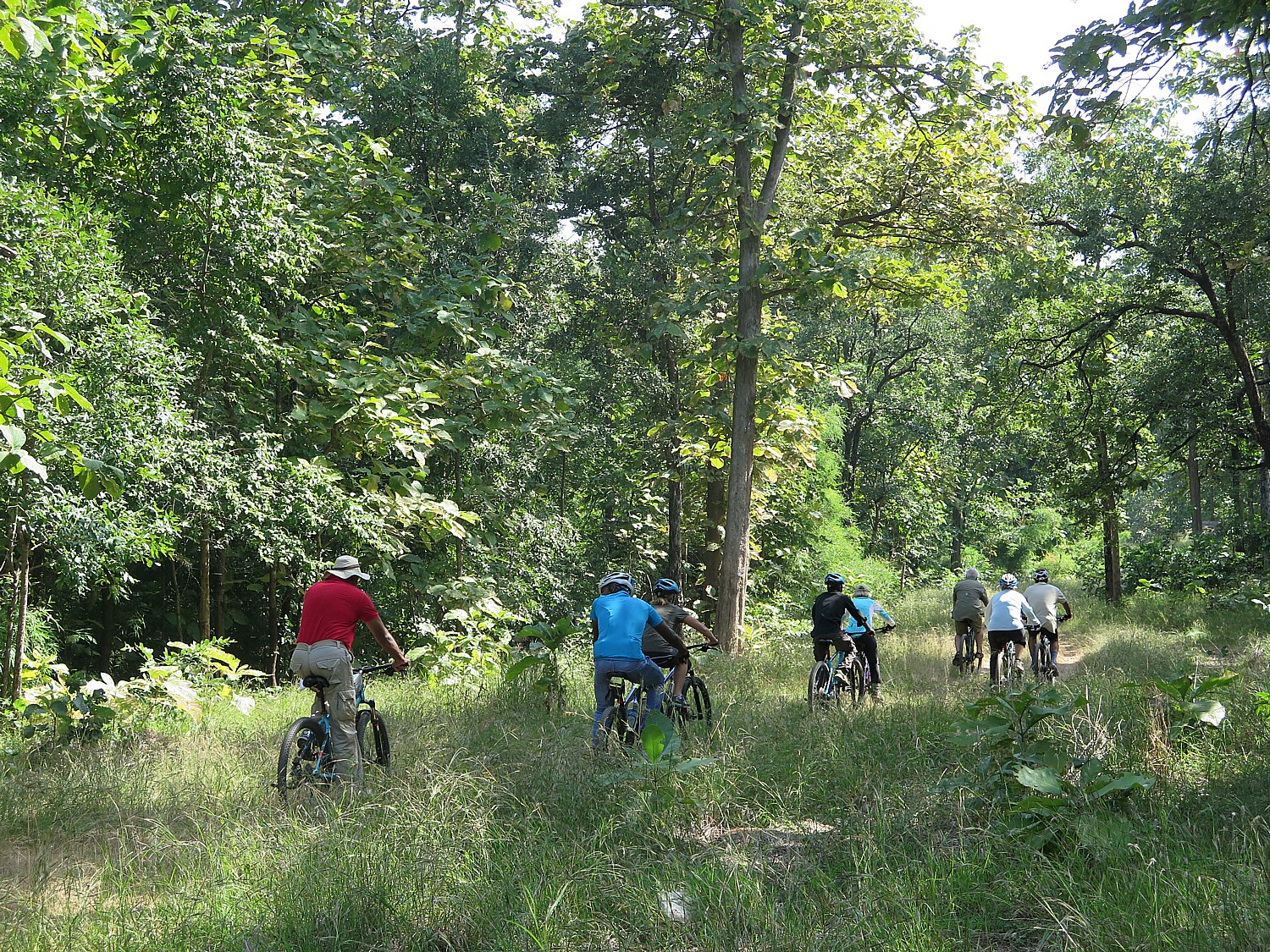
At one point, I find myself (inexplicably) well ahead of our group (which has as many guides, cycle experts and leaders as we tourists), including a jeep and a van loaded with supplies with snacks and our lunch that will be set up at the end of a ride in a guesthouse.
Here I am, in a stretch of high, dense grass that reaches up to my knee, with dense forest on both sides. I decide this isn’t the place to be alone – after all, the naturalist said that the tigers who live here (there are 8 who live in the corridor, and about 120 between the two national parks) are craftier, more intelligent, because they have less food (that is, not as many deer and monkeys to munch), that they take advantage of the denser forest growth to surprise their prey, and are less used to humans (which I take to mean less afraid of humans and I am not particularly reassured that tigers don’t like the smell or taste of humans – how do they know?). Putting that together, I realize I am the slowest prey around, so I ride back to meet up with the riders, recalling that old adage: you don’t have to be the fastest, just faster than someone else.
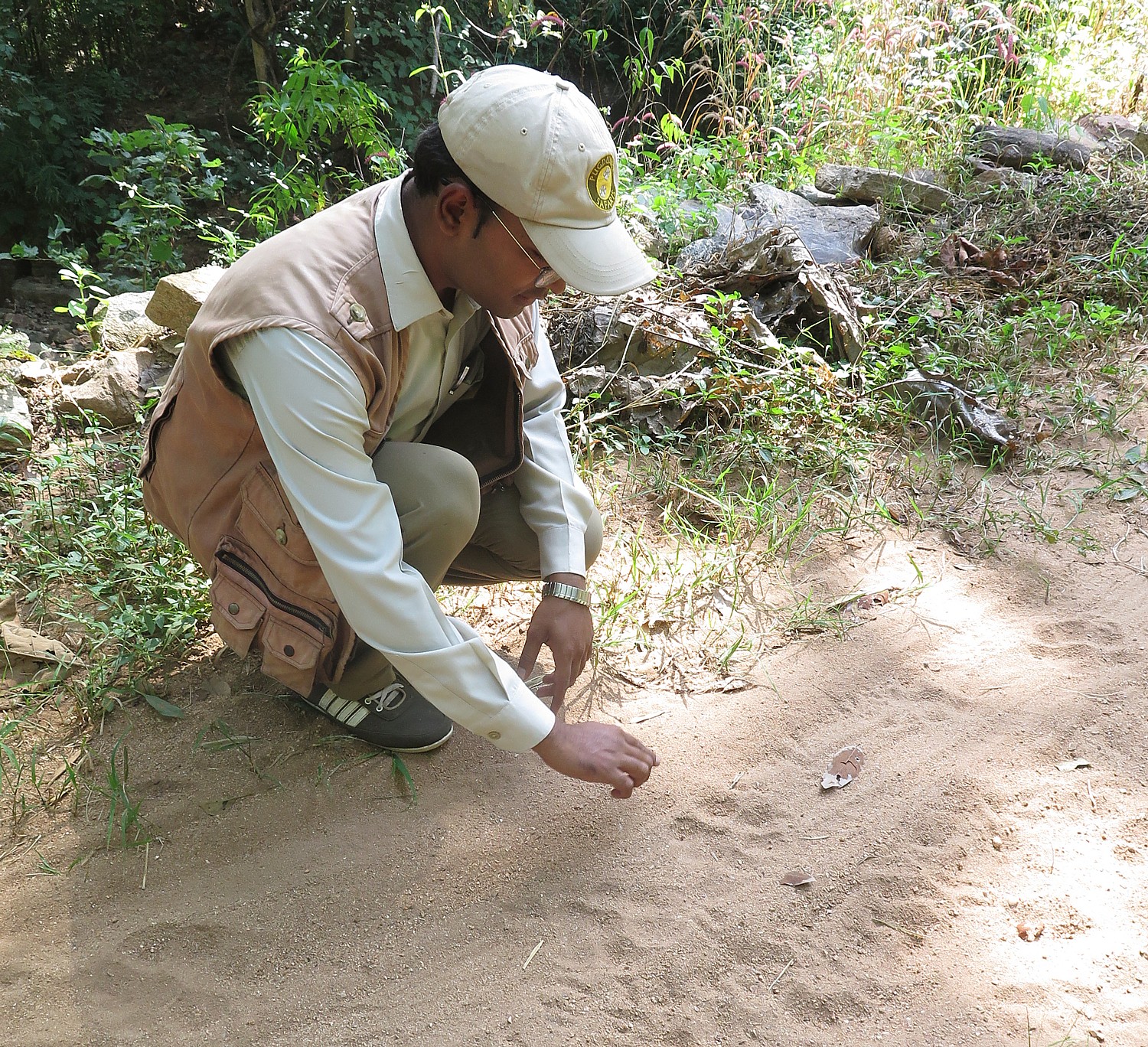
That thought plays around in my mind, adding to the adventure and sense of bravery – courage – that I’ve known only a couple of times in my life – that makes the exhilaration you feel after the ride- and not just from the physical challenge – all the sweeter and richer. It’s a sense of personal triumph, of overcoming fear (of course, the danger was minimized by the safari vehicles which followed us and the guides who accompanied us, outnumbering our small band, not to mention we are here in mid-day when the scariest animals are least likely to be out and about and hunting. Still.
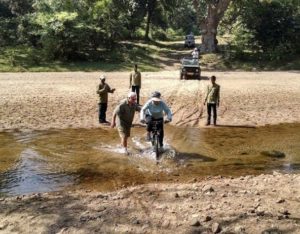
That 25 km ride proves the most challenging cycling of Royal Expeditions’ unique and creative “Jungle Book Wildlife Safari & Cycling” tour. Vishal Singh, who designed the trip, said it was more challenging than expected because it was so soon after the rainy season. But it is exhilarating and thrilling and totaling fabulous – that sense of actual adventure and physical challenge – that also includes crossing a stream (I chicken out and find a place to walk across rocks).
Most of the rides we take are challenging in their own way, but go through villages and past farms, giving us a unique perspective on local life.
The itinerary is set in the same region that provided the setting for Rudyard Kipling’s “Jungle Book” which he published in 1895, in central India, cycling through the same jungles (the word is Hindi for “forest”).
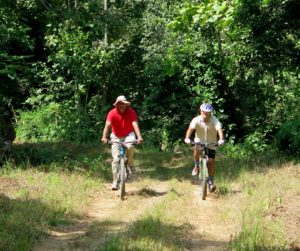
This corridor, we are told, plays an important part in the conservation of the tigers – by linking the two national parks, which between them have about 120 tigers, helps promote diversity in the gene pool, and provides protected habitat for their long-term survival. Other tiger habitats in India are fast becoming islands and there is little change in genetic pool of the tiger population. The landscape also supports diverse land use, and traditional forest dwelling tribal communities.
Our visit, we are told, also has the function of raising awareness among local communities of the part they play in wildlife conservation (indeed, just days after our visit, Vishal Singh is leading a 160 km fundraising ride that goes along the entire forest corridor linking Pench and Kanha, to supply locals with smart phones so they can alert authorities to poaching).
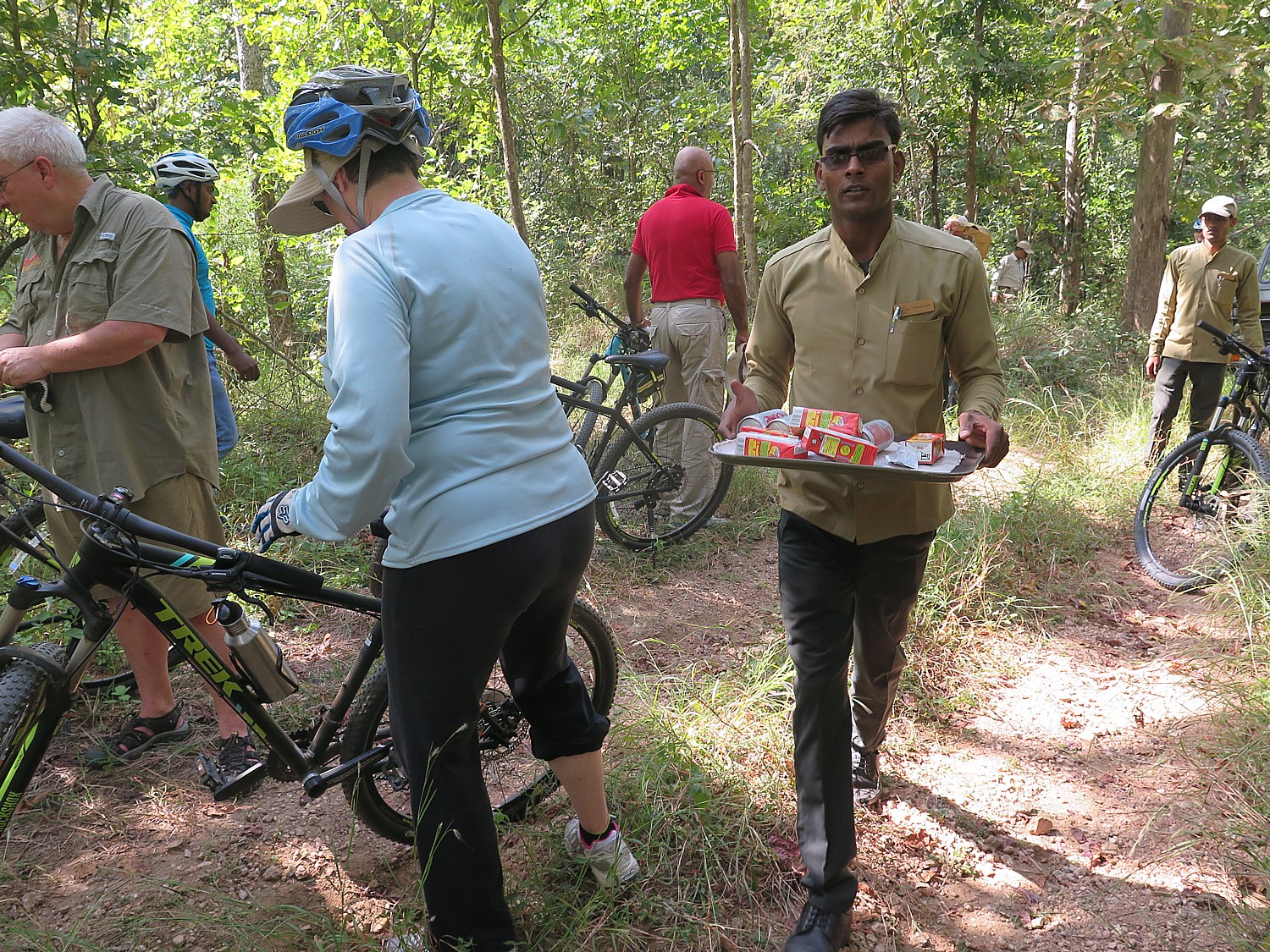
A safari vehicle and van follow behind us (in case somebody can’t finish the ride). Every time we stop, a couple of fellows guys jump out, smartly dressed in their Pench Tree Lodge uniforms, and refill our water bottles, offer drinks in glasses, and offer snacks on a silver tray.
Our ride is accompanied by Sagor Mahajan, our naturalist from the Pench Tree Lodge, who stops along the way (as much as to give us a rest as to impart wisdom) to point out spiders interesting trees and plants, and tell us about work been done by conservation organizations to save this critical landscape.
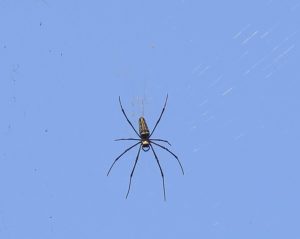
For once in my life, I’m more fascinated than afraid of these gigantic insects: he points to a funnel web spider which makes an elaborate funnel and lives inside; and a giant (really gigantic) female wood spider (the male is much smaller and the female eats the male after mating unless there is some better food available). He says they make bullet-proof jackets out of its web that is four times stronger than stainless steel. He points out Wandering Gliders – dragonflies that are the longest migrating insect, traveling from India to southern Africa, taking four to five generations to cover the distance; many bird species depend on the migrating gliders for food. As for how they know where to go? The wind temperature and humidity give them the direction and some suggest that the magnetic induction of the earth plays a part, like for sea turtles.
He points out lichen on a tree, which is a sign that there is no pollution in this forest (significant considering that while we are in India, New Delhi has had to close its schools because the air pollution is so severe); indeed, the clear, crisp air is one of the reasons so many Indian people escape to these parks for relief.
When we come upon tiger pugmarks, he shows us how to identify that it is male (more rounded toes), while the female’s is more pointed.
I learn that tigers are endangered while leopards are not, and it has a lot to do with the way they have evolved. Leopards can climb trees so have access to more prey like monkeys, and hunt mainly at night. A tiger male will only mate with a few females, and if she has cubs, will kill them in order to mate.
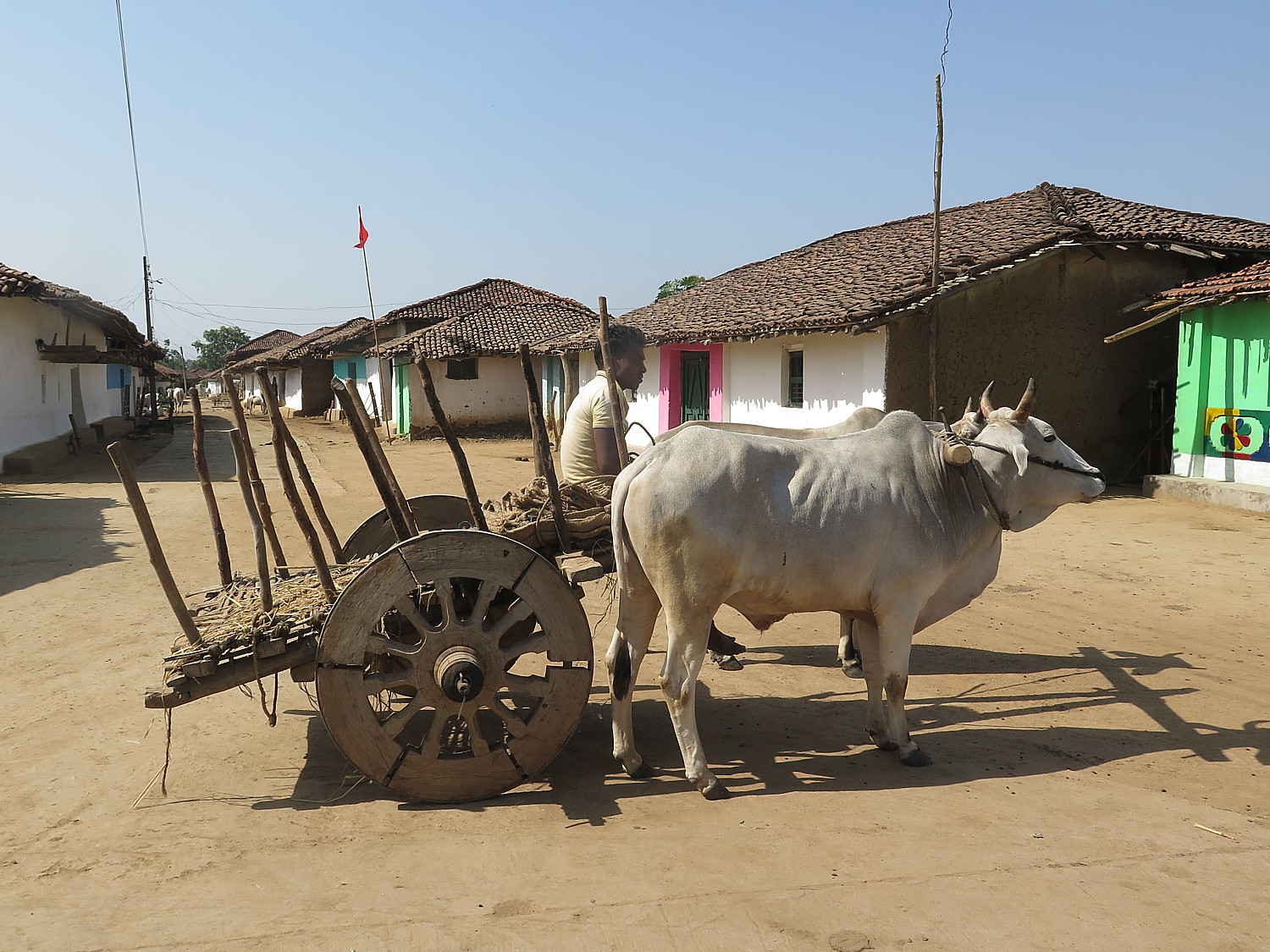
The last 5 K of the 25K ride takes us through villages and passed farms where we watch people working in the fields, using scythes to cut down rice, and plows pulled by bulls. Our ride ends at the Sakata Forest Rest House, built in 1903 for the officers who patrolled the area (tourists can rent rooms here), where the staff of the Pench Tree Lodge sets up a fantastic lunch which we enjoy under a thatch-covered pavilion.
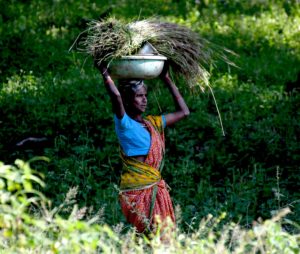
We are among the first to do this cycling trip through this sanctuary – when you think about it, people are not allowed out of the safari vehicles otherwise, but here we are, on our bikes, or walking about with nothing between us and the wild animals who live here. Vishal Singh, the managing director of Royal Expeditions, who accompanies us on this trip, has used his personal connections (his company was founded by a royal family of Jodhpur and connected to a Princess who also served in Parliament and as the Minister of Culture), to convince the officials who control the sanctuary to issue permits for our cycling adventure.
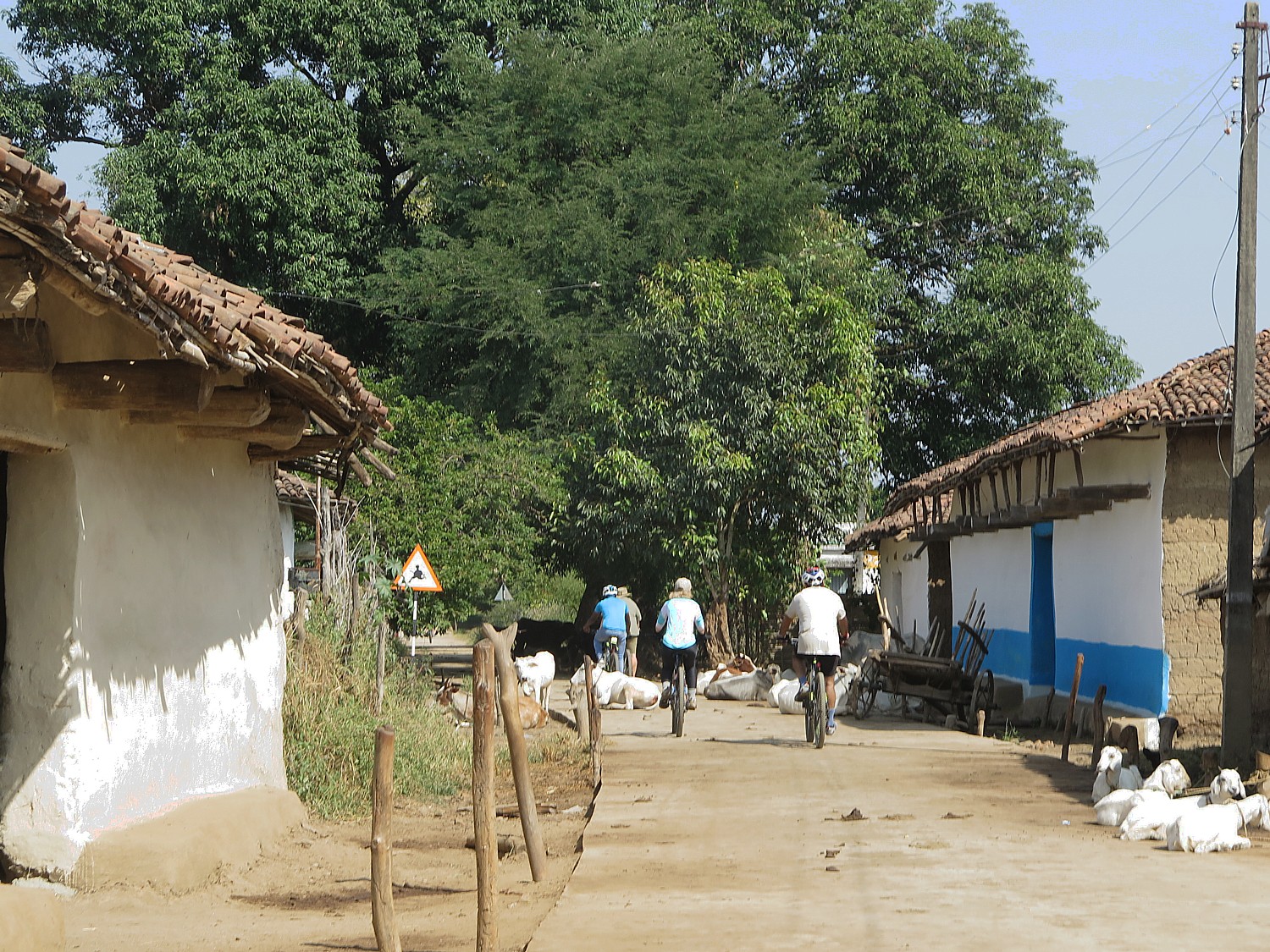
Some experiences are billed as “adventure” and wind up being as tame as a Disney themepark ride (though I have new respect for Disney’s Animal Kingdom safari ride). This really is adventure – even more than I had imagined it would be – actual mountain biking where we need to navigate rocks, sand, gravel, ruts, tall grass, descents and some climbs, and a small stream.
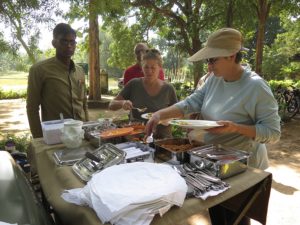
After lunch, Vishal offers us the option of biking back along the same forest corridor – that is, 25K back, and this time, mostly uphill through the same high grass and broken, sandy and gravel trail. Not to mention it is already about 3 pm in the afternoon and it took about 4 hours to get here. We are really quite tuckered from what we have done, so everyone opts to pile onto the safari vehicle which has followed after us, along with the van that has been carrying the bike trailer (in case someone couldn’t finish the ride). We take satisfaction in the fact that it is even a difficult, rumbling ride back in the vehicle – and really can’t believe we did this by bike.
Pench Tree Lodge
What makes the experience all the more special are the accommodations: My room at Pench Tree Lodge (www.PenchTreeLodge) which only opened in 2016, is literally a tree house, built of all natural materials, but with stunning design, local and traditional art, and every comfort and amenity you could crave. There are just six of these tree house accommodations, spread over 16 acres (including a fantastic lap-size swimming pool (so much fun to swim and watch the green parakeets flying above). Meals, prepared by a sensational chef, Pankaj Fulera, (he was runner-up for Best India Chef and is equally adept at traditional Indian cuisine as fusion Continental, are served in a charming dining lodge where there are also lovely sitting areas. One night, they set up a dinner outside, under the boughs of a tree I call the Tree of Life, with firelight.

Pench Tree Lodge is located near the Karmajhiri gate into Pench National Park, which is gets a lot less tourist traffic and you really feel immersed in local life.
The forest region (“jungle” is the Hindi word for forest) is where Rudyard Kipling set his story of Mowgli, the boy raised by wolves, and his nemesis, Shere Khan, the tiger. During the course of our visit in Pench, which includes game drives into Pench National Park, we see many of the characters that populated his story and the landscape in which they thrived. Later, I learn that there may be some truth to the legend.
For more information, contact Royal Expeditions Pvt. Ltd. www.royalexpeditions.com, [email protected], or Royal Expeditions’ North American representative: [email protected], 720-328-8595.
Next: “Jungle Book Wildlife Safari & Cycling Adventure” in India continues
____________________
© 2016 Travel Features Syndicate, a division of Workstyles, Inc. All rights reserved. Visit goingplacesfarandnear.com and travelwritersmagazine.com/TravelFeaturesSyndicate/. Blogging at goingplacesnearandfar.wordpress.com and moralcompasstravel.info. Send comments or questions to [email protected]. Tweet @TravelFeatures. ‘Like’ us at facebook.com/NewsPhotoFeatures
